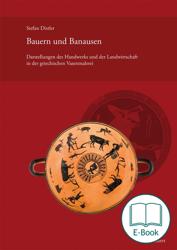Vase painting is one of the most important sources of information regarding labour in the ancient world. This comprehensive iconographic study focuses on the depiction of physically active persons. It deals not only with representations of skilled crafts but also with images of agriculture that are presented here in detail for the first time. This study scrutinises the discrepancy between the assessments and views of artisanal and agricultural activities that can be gleaned from the sparse written sources and how these tasks are represented in the visual arts. It illustrates how different views of social stereotypes can result in very disparate imagery.
Only a very few representations of working people are preserved in the art of ancient Greece. In stark contrast to, for example, the Egyptian and Roman cultures, images of the simple life of people from lower social strata were never very popular and were perennially overshadowed by Hellenic art portraying aristocratic values and ideas.
Much of the population of ancient Greece certainly worked in one way or another but sources for this basic and essential part of ancient life are very sparse, which is why vase paintings are so very important. A rather remarkable number of these portrayals has survived to give us a unique and multifaceted insight into the Greek world of work and, more notably, ideas.
This study focuses on representations of humans performing physical labour.
The images include portrayals of skilled crafts as well as the agricultural images that have been sorely neglected by previous research. Almost 150 primarily Attic vase paintings, created in the period from the later 7th to the beginning of the 4th century BCE, are presented here for the first time as a collection. Together, they demonstrate the diverse activities carried out in workshops and fields as well as the people involved – from workshop owners to unskilled workers, foremen and day labourers. This study scrutinises the discrepancy between the assessments and views of artisanal and agricultural activities that can be gleaned from the sparse written sources and how these tasks are represented in the visual arts. What role was played by the image of the peasant? Although this question was already touched upon during antiquity, it is even more important in modern research. What unites these figures with and what distinguishes them from characters of the agricultural world, held in high esteem since time immemorial but sometimes also judged with ambivalence? And what information can we gain from these images in general?
With a comprehensive material base available for the first time, this meticulous iconographic study of pictorial records provides answers to these questions and illustrates how different views of social stereotypes can result in very disparate imagery.
- Born on 10/15/1982
- Studied Classical Archeology and Prehistory at the University of Regensburg.
- 2016 Doctorate in Classical Archaeology at the University of Regensburg; Dissertation: Bauern und Banausen – Darstellungen des Handwerks und der Landwirtschaft in der griechischen Vasenmalerei.
- Since 2020 research assistant at the Bavarian Academy of Sciences and processor of the Kleinmeister cups of the Berlin Antiquities Collection as part of the Corpus Vasorum Antiquorum project.
- Main research: Greek vase painting, archaic ceramics, ancient iconography, the sanctuary of Olympia and working and social life in antiquity.


 Table of Contents
Table of Contents